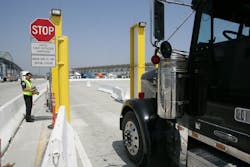Brian Jenkins, director of the transportation safety and security center within the Mineta Transportation Institute, is quick to stress that cargo theft and terrorism are two “vastly different spheres” of concern within the transportation industry.
Yet they can be partially linked by the role insider information plays within criminal and terrorist activity aimed at transportation networks, so it behooves industry executives to be mindful of ways to counteract the insider threat, he explained to Fleet Owner.
“There are no usually obvious behavioral indicators” when it comes to insider betrayals, Jenkins emphasized: “There is no x-ray for a man’s soul.” But the insider threat is one with a long history in transportation circles – especially against railroads – and thus needs to be accounted for in a company’s security protocols.
“Insiders are persons who, as a result of their position, possess confidential knowledge about or have privileged access to facilities and operations,” Jenkins noted in a recent white paper on the subject.
“Criminal insiders decide on their own or are suborned by others to use such knowledge or access to threaten, carry out, or assist others to carry out theft, armed robbery, extortion, sabotage, and espionage,” he pointed out. “Their decision to betray the trust placed in them by the government or an employer may reflect personal motives, such as greed, revenge, or mental disorder, or group grievances related to labor demands or ideological causes.”Insiders pose a special problem for those charged with security, Jenkins stressed, because although knowledge and access can be restricted according to levels of trust, even menial positions require access and knowledge of how things work.
For example, one of the terrorists engaged in the bombing of the Brussels Airport back in March previously worked at a low-level cleaning job at that facility for five years, most likely to gain inside information on security procedures.
“The status of such employees may be regularly reviewed, but that is costly, and even in intelligence services where individuals are subjected to the most rigorous background investigations and continuing surveillance, there is still no guarantee of continuing fidelity,” Jenkins noted. “Insiders can be dangerous adversaries.”
And insider can be dangerous in other ways as well. For example, half of the cases of sabotage involving insiders in the MTI database are related to labor strife, while a RAND Corp. study of “high-value heists”—sophisticated thefts and robberies—found that insider assistance was suspected in at least one-third of the cases.
On top of that, analysis by Kroll Associates showed that more than 90% of the cases of economic espionage in the 1990s were carried out by insiders who had access to the information stolen.
So what can transportation companies do to better address the “insider threat” with their security procedures? Jenkins offers a few tips:
- You must devote more internal resources to pre-hiring screening and ongoing analysis of vulnerabilities. “You need to address security internally in a cohesive fashion and realize law enforcement can’t always help you with day-to-day threat analysis,” he said.
- Do you have some way to elicit tips from employees, a way to pass on information regarding suspicious behavior?
- Insider threats are not always obvious in terms of behavior but there can be indicators: drug addiction or gambling debts, where people get in a jam over debts, or spending way out of line with earnings, such as a low level employee with “two Ferraris and a Bugatti” parked in the driveway.
- Threats increase with the value of the shipment. “The higher the level of security required for cargo, the more likelihood there is of an insider threat,” Jenkins notes.
He stresses, however, that “insiders” are not all potential killers, either.
“Although they may be willing to betray the trust placed in them, their actions may be constrained by reluctance to harm innocent people or fellow employees,” Jenkins pointed out.
“In terms of the threat to human life, the most dangerous insiders are those who are in a position to create disasters and who, because of mental disorder or powerful beliefs, have no such constraints,” he said. “For example, there have been five incidents of a commercial pilot crashing a plane filled with passengers since 1982; crashes that have resulted in 539 deaths.”
About the Author
Sean Kilcarr
Editor in Chief
Sean Kilcarr is a former longtime FleetOwner senior editor who wrote for the publication from 2000 to 2018. He served as editor-in-chief from 2017 to 2018.

